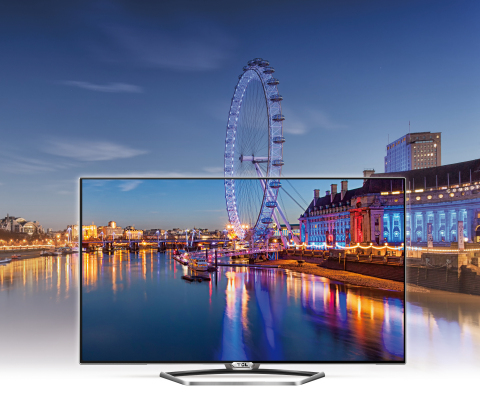
Shopping for a TV can be hard. One look at the Newegg website should be enough to convince you that TV technology is among the most elaborate. This is because you not only have to keep up with the latest terminology, but there are also many different options to choose from — and all of them are good.
TV technology has become so advanced that you really can’t go wrong with whatever you choose to buy. Whether it’s LED, Plasma, Smart, 3D, 4K or Curved; they all provide excellent displays and offer a variety of impressive features.
But just when you thought you figured out what all those acronyms mean, there’s a new technology destined to hit it big in 2015 that could eventually replace them all: Quantum Dots.
Quantum Dots Make TVs Better

Quantum Dots with gradually stepping emission from violet to deep red.
A Quantum Dot is a nanocrystal composed of tiny semiconductor materials that have quantum mechanical properties. In other words: they make colors look better because they can be dialed in perfectly. This is possible because QDTVs have a wide color palette and better color saturation than regular LCD TVs.
Sony became the first manufacturer to offer a QDTV in 2013 when it launched its XBR X900A series. These TVs were also the first to offer 4K UHD technology that was smaller than 84 inches. And while they were quite impressive, they weren’t very affordable.
Starting at $5,000 for a 55-inch model, not many people took advantage of the brilliant display because it was considered too expensive. And because it was branded as “Trilumimos Display LED backlighting,” nobody really knew what Quantum Dots even were.
But times have changed.
Just two years later, it’s now possible to buy a 4K TV that costs less than $400. It’s also possible to make QDTVs much cheaper and manufacturers have noticed. Most notably, LG, who just announced they will be launching a QDTV in early 2015 that will help them cut costs while saving you money.
QDTVs are the Best Bang for Your Buck
Quantum Dots are advantageous to manufacturers because they are small and cheap. Measuring between 2 and 10 nanometers, they also make it easier to generate precise colors. The end result is better technology that actually costs less.
LG hasn’t disclosed how much their QDTVs will cost but we can expect them to be much cheaper than what we currently pay for OLEDs. Such is the case with China’s TCL who is selling a 55-inch UHD TV with Quantum Dot technology at one-third the price of a comparable OLED.

TCL’s new 55″ 4K TV with Quantum Dot technology.
“We are pleased to extend our relationship with QD Vision to the exciting new 4K UHD world. The addition of QD technology to our 4K televisions will offer great value to consumers who want to enjoy the advanced picture quality with vivid colors and shaper images.”
— E. Hao, CEO of TCL Multimedia
Quantum Dot technology will usher in a new era for televisions because it will bring the best image possible at an affordable price. LG and TCL aren’t the only ones who’ve noticed either. Many analysts expect Samsung to launch their own QDTVs next year and “be more aggressive in pushing the products than LG” because the latter is still committed to OLED. This is significant because Samsung and LG represent the world’s two largest TV manufacturers.
Setting the Standard
It’s impossible to predict the success of Quantum Dot technology but it probably won’t replace what’s currently available. A QDTV still requires an LCD panel and this limits how much color it can actually produce. So while Quantum Dots do improve an LCD TV’s performance, the picture quality will still be compared to OLED displays.
But this isn’t a bad thing.
When OLED TV’s first launched in 2013, less than 500 units were sold in the United States. And with a $10,000 price tag I don’t blame you for not buying one. I will, however, be a little suspicious if you don’t purchase a QDTV that looks just as good as an OLED display but costs one –third the price.
What do you think? Will QDTVs be successful? Can Quantum Dots replace current TV technology? Are you buying a QDTV? Let us know in the comments below!

